|
Coral studies
Self-fertilization as a mechanism for population maintenance in
a changing environment
 This
project, funded by the European Institutes of Advanced Studies (EURIAS),
aims to determine the extent of self-fertilization for
population maintenance as well as the effects of population
demography on rates of self-fertilization in the Mediterranean
coral Balanophyllia europaea. Using microsatellites,
baseline genotypic diversity will be determined and rates of
self-fertilization compared among sites of varying density to
test for associations with population demography. It is
hypothesized that as habitat destruction and deterioration
increases and population density declines, rates of
self-fertilization will increase as distances between
individuals increases. Understanding how rates of
self-fertilization vary with environmental parameters will
assist in efforts to predict future changes to coral populations
associated with global climate change. This
project, funded by the European Institutes of Advanced Studies (EURIAS),
aims to determine the extent of self-fertilization for
population maintenance as well as the effects of population
demography on rates of self-fertilization in the Mediterranean
coral Balanophyllia europaea. Using microsatellites,
baseline genotypic diversity will be determined and rates of
self-fertilization compared among sites of varying density to
test for associations with population demography. It is
hypothesized that as habitat destruction and deterioration
increases and population density declines, rates of
self-fertilization will increase as distances between
individuals increases. Understanding how rates of
self-fertilization vary with environmental parameters will
assist in efforts to predict future changes to coral populations
associated with global climate change.
Modeling
the main factors driving the ecology of the open waters of the
northern gulf of Aqaba (Red Sea)
 Thanks
to the project "Protecting
the Gulf of Aqaba from Anthropogenic and Natural Stress",
which is supported by the program
“The NATO
Science for Peace and
Security Programme (SPS)”,
a model will be developed to verify the
current situation and the future modifications of water quality in the
Aqaba Gulf (Red Sea). The model will be useful
to assess the degeneration of water conditions near the cities of Aqaba
(Jordan) and Eilat (Israel), to project the environmental conditions of
the gulf and the consequent restoration actions that may be adopted to
protect it. Thanks
to the project "Protecting
the Gulf of Aqaba from Anthropogenic and Natural Stress",
which is supported by the program
“The NATO
Science for Peace and
Security Programme (SPS)”,
a model will be developed to verify the
current situation and the future modifications of water quality in the
Aqaba Gulf (Red Sea). The model will be useful
to assess the degeneration of water conditions near the cities of Aqaba
(Jordan) and Eilat (Israel), to project the environmental conditions of
the gulf and the consequent restoration actions that may be adopted to
protect it.
Read the
presentation
 2010-2015 Corals and Global Warming: 2010-2015 Corals and Global Warming:
the Mediterranean versus the Red Sea
Project financed by the European Research Council under the
IDEAS scheme of the VII Framework Program. Conceived by MSG, it
has the aim of studying the potential effects of global warming
and acidification on biology and ecology of Mediterranean and
Red Sea corals. The project is multidisciplinary, in that it
uses biological, chemical and physical techniques, and it
benefits from the collaboration between the labs of the
University of Bologna and the Bar-Ilan University of Tel Aviv.
Go to project
website
Mediterranean corals research themes
Reproductive biology:
The
 reproductive
cycles of Mediterranean scleractinians are defined by using
hystological tchniques. The definition of sexuality and
reproductive mode is perfomed through observation of
hystological samples by optical microscopy. Cytometric
measurements are performed by using image analysis software. The
observations allow to identify and quantify the germ cells in
each polyp, thus delineating the gonadal maturation stages, the
fertilization time, and the embryogenesis, which will culminate
in the planulation of new individuals. The sexual reproduction
cycle is influenced by the seasonal variations of seawater
temperature and photoperiod. The analyses are performed on
populations characterized by different environmental parameters,
to verify their influence on reproductive traits of the studied
species. reproductive
cycles of Mediterranean scleractinians are defined by using
hystological tchniques. The definition of sexuality and
reproductive mode is perfomed through observation of
hystological samples by optical microscopy. Cytometric
measurements are performed by using image analysis software. The
observations allow to identify and quantify the germ cells in
each polyp, thus delineating the gonadal maturation stages, the
fertilization time, and the embryogenesis, which will culminate
in the planulation of new individuals. The sexual reproduction
cycle is influenced by the seasonal variations of seawater
temperature and photoperiod. The analyses are performed on
populations characterized by different environmental parameters,
to verify their influence on reproductive traits of the studied
species.
Biometry and population dynamics: The relationships between
 morphological
features of skeletons along the lifespan of the animal are
analyzed. Skeleton age can be determined through
sclerochronology, that is the observation of the typical yearly
growth bands of the skeleton. By applying mathematical models,
it is possible to determine polyp growth rates along their
lifespan, based both on sclerochronological data and on field
measurements. From these data, the main growth characteristics
are determined: linear extension, skeletal density, and
calcification. By analyzing population age structures and
applying proper models, important demographic parameters of the
populations are derived, such as mortality rate, average
lifespan, and yield. All these characteristics are compared
among populations subjected to different environemntal
parameters, and among different scleractinian species. morphological
features of skeletons along the lifespan of the animal are
analyzed. Skeleton age can be determined through
sclerochronology, that is the observation of the typical yearly
growth bands of the skeleton. By applying mathematical models,
it is possible to determine polyp growth rates along their
lifespan, based both on sclerochronological data and on field
measurements. From these data, the main growth characteristics
are determined: linear extension, skeletal density, and
calcification. By analyzing population age structures and
applying proper models, important demographic parameters of the
populations are derived, such as mortality rate, average
lifespan, and yield. All these characteristics are compared
among populations subjected to different environemntal
parameters, and among different scleractinian species.
Biomineralization: The process responsible for the formation
of
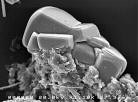 scleractinian
skeletons, which are composed by calcium carbonate and by an
intraskeletal organic matrix, is analyzed. Both skeletal
analyses and in vitro crystallization experiments are performed,
to understand the skeletal precipitation process and the level
of control by the organism.
The skeleton is analyzed by infrared spectroscopy (FTIR), X ray
diffractometry (XRD), and thermogravitometry (TGA).
These analyses are used to determine the composition of the
skeletons and to quantify the percentage of organic matrix
inside them. Then, in vitro crystallization experiments are
performed with the presence of different concentrations of
magnesium (environmental control) and organic matrix (biologic
control) extracted by the skeleton. Experimental products are
analyzed through microscopic techniques, to assess possible
morphological variations, and spectroscopic techniques, to
verify the precipitated calcium carbonate polymorph. Different
species and populations at different environmental parameters
are compared. scleractinian
skeletons, which are composed by calcium carbonate and by an
intraskeletal organic matrix, is analyzed. Both skeletal
analyses and in vitro crystallization experiments are performed,
to understand the skeletal precipitation process and the level
of control by the organism.
The skeleton is analyzed by infrared spectroscopy (FTIR), X ray
diffractometry (XRD), and thermogravitometry (TGA).
These analyses are used to determine the composition of the
skeletons and to quantify the percentage of organic matrix
inside them. Then, in vitro crystallization experiments are
performed with the presence of different concentrations of
magnesium (environmental control) and organic matrix (biologic
control) extracted by the skeleton. Experimental products are
analyzed through microscopic techniques, to assess possible
morphological variations, and spectroscopic techniques, to
verify the precipitated calcium carbonate polymorph. Different
species and populations at different environmental parameters
are compared.
Population genetics:
Self-fertilization rates are studied
by using 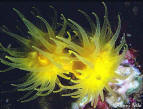 molecular
biology techniques aimed at particular DNA sequences, called
microsatellite sequences.
These sequences allow to assess the genetic differences between
adult individuals and their progeny. It is also possible to
assess the genetic variability and connectivity among different
populations. molecular
biology techniques aimed at particular DNA sequences, called
microsatellite sequences.
These sequences allow to assess the genetic differences between
adult individuals and their progeny. It is also possible to
assess the genetic variability and connectivity among different
populations.
Skeletal mechanical properties:
Investigation of
mechanical
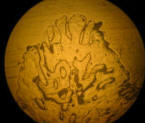 properties
benefits of recent techiniques of instrumented nanoindentation.
Indenting means: to bring to contact the indentator-probe, which
is highly rigid and unaltered by the interaction, and the
sample. During this procedure, the instrument measures the
applied force and the depth of penetration in time.
The software can assess the hardness (resistance of the
materiaal to plastic deformation) and the Young's elastic
modulus (response in a ragime of reversible deformation), which
are the two quantities who better define the mechanical features
of an object. Before the indentation, a study of porosity is
perfomed through nuclear magnetic resonance (NMR) in the time
domains, to obtain information on the quantity and size of
skeletal pores. properties
benefits of recent techiniques of instrumented nanoindentation.
Indenting means: to bring to contact the indentator-probe, which
is highly rigid and unaltered by the interaction, and the
sample. During this procedure, the instrument measures the
applied force and the depth of penetration in time.
The software can assess the hardness (resistance of the
materiaal to plastic deformation) and the Young's elastic
modulus (response in a ragime of reversible deformation), which
are the two quantities who better define the mechanical features
of an object. Before the indentation, a study of porosity is
perfomed through nuclear magnetic resonance (NMR) in the time
domains, to obtain information on the quantity and size of
skeletal pores.
Closed projects
 Red
Sea corals research themes Red
Sea corals research themes
Fungidae
- Study of ecological distribution, abundance and population dynamics
of tropical mushroom corals from the Red Sea. An international
Italian-Israeli collaboration with the Interuniversity
Institute for Marine Science of Eilat.
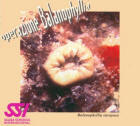 "Balanophyllia europaea
Operation", started on 1997, was the first research on
reproductive mode and demographic characteristics of
Mediterranean hard corals. "Balanophyllia europaea
Operation", started on 1997, was the first research on
reproductive mode and demographic characteristics of
Mediterranean hard corals.
Read the project report |
Environmental monitoring
2006-2014
"STE
- Scuba Tourism for the Environment"
-Red Sea Biodiversity Monitoring Program
 Human
activities cause the loss of many plants and animals, and create
"altered, unnatural" environments which appear biologically
homogeneous, dominated only by a few resistant species. "Unaltered,
natural" environments, instead, display a high degree of
biological heterogeneity, since the host many animal and plant
species which are in equilibrium. This research, started on 2006,
has the aim of assessing the biodiversity of coral reefs along
Red Sea coasts, and thus assess its healthy state. The data,
since 2007, will be collected by underwater tourists by
recording a special questionnaire. The first stage of the
project was concluded on 2010, with more than 17500
questionnaires. The second stage, currently underway, will end
up on 2014. Human
activities cause the loss of many plants and animals, and create
"altered, unnatural" environments which appear biologically
homogeneous, dominated only by a few resistant species. "Unaltered,
natural" environments, instead, display a high degree of
biological heterogeneity, since the host many animal and plant
species which are in equilibrium. This research, started on 2006,
has the aim of assessing the biodiversity of coral reefs along
Red Sea coasts, and thus assess its healthy state. The data,
since 2007, will be collected by underwater tourists by
recording a special questionnaire. The first stage of the
project was concluded on 2010, with more than 17500
questionnaires. The second stage, currently underway, will end
up on 2014.
Go to project
website
Closed projects
2002-2005 "Divers
for the Environment"
- Mediterranean Underwater Biodiversity Project
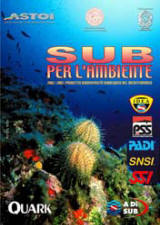 Human
activities cause the loss of many plants and animals, and create
"altered, unnatural" environments which
appear biologically homogeneous, dominated only by a few
resistant species. "Unaltered, natural" environments, instead,
display a high degree of biological heterogeneity, since the
host many animal and plant species which are in equilibrium.
This research started on 2002, with the aim of assessing the
biological divesity degree of marine environments along italian
coasts, by considering the distribution of some organisms
considered as indicators. Data were collected by recreational
divers through the recording of a special questionnaire. Human
activities cause the loss of many plants and animals, and create
"altered, unnatural" environments which
appear biologically homogeneous, dominated only by a few
resistant species. "Unaltered, natural" environments, instead,
display a high degree of biological heterogeneity, since the
host many animal and plant species which are in equilibrium.
This research started on 2002, with the aim of assessing the
biological divesity degree of marine environments along italian
coasts, by considering the distribution of some organisms
considered as indicators. Data were collected by recreational
divers through the recording of a special questionnaire.
Go to project website
1999-2001 "Mediterranean
Hippocampus Mission"
 Started
on 1999,
it was the first research on the geographical and ecological
distribution of Mediterranean seahorses. The aim of this research
was to collect information on the quality of marine environment by
using, instead of traditional chemical anlyses, which are expensive
and limited, a biological indicator, which is a delicate organism
who indicates a better or worse environmental quality depending on
its presence or absence, respectively. The selected organism was the
seahorse,
Hippocampus hippocampus and
Hippocampus ramulosus. Project results were published on the
scientific journal Conservation Biology, published by the American
Society of Conservation Biology. Started
on 1999,
it was the first research on the geographical and ecological
distribution of Mediterranean seahorses. The aim of this research
was to collect information on the quality of marine environment by
using, instead of traditional chemical anlyses, which are expensive
and limited, a biological indicator, which is a delicate organism
who indicates a better or worse environmental quality depending on
its presence or absence, respectively. The selected organism was the
seahorse,
Hippocampus hippocampus and
Hippocampus ramulosus. Project results were published on the
scientific journal Conservation Biology, published by the American
Society of Conservation Biology.
Read the project report |